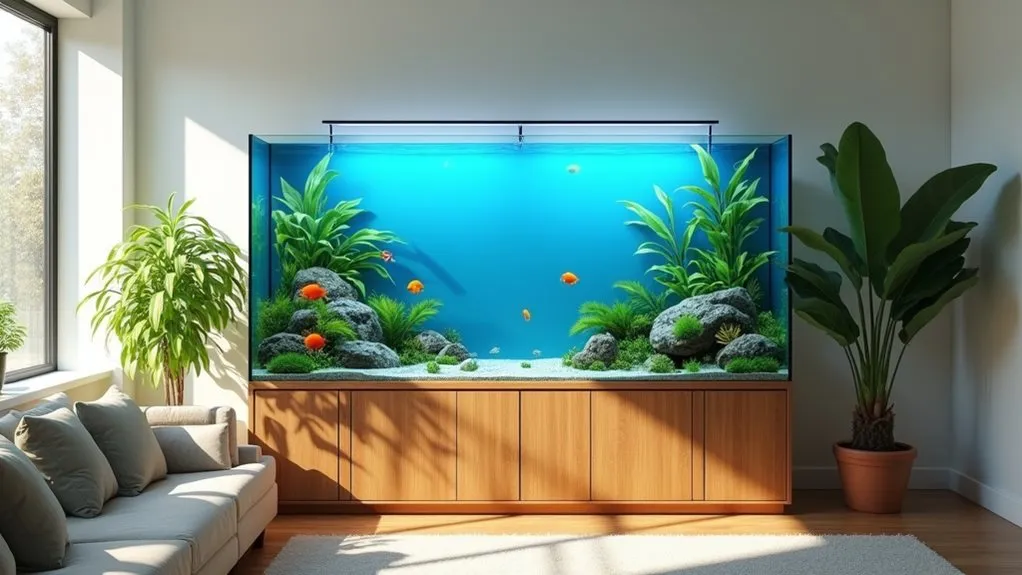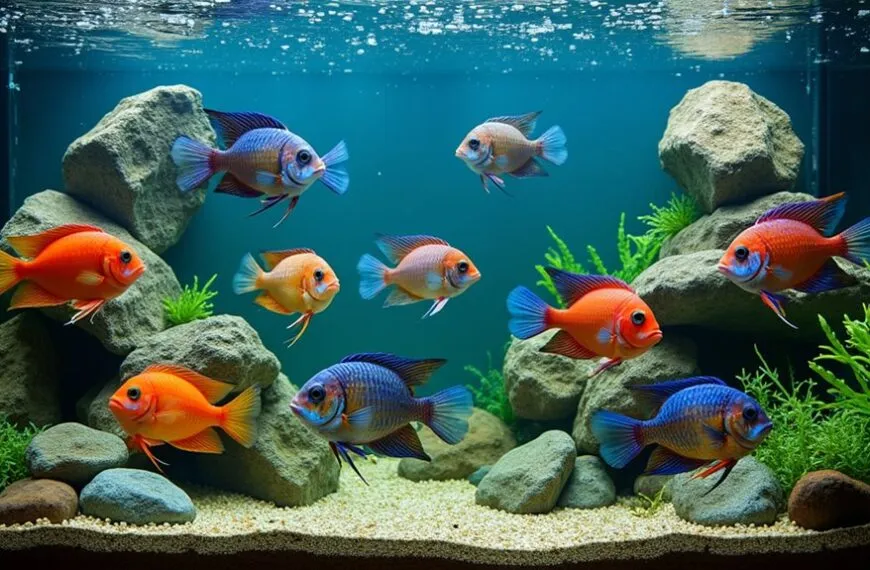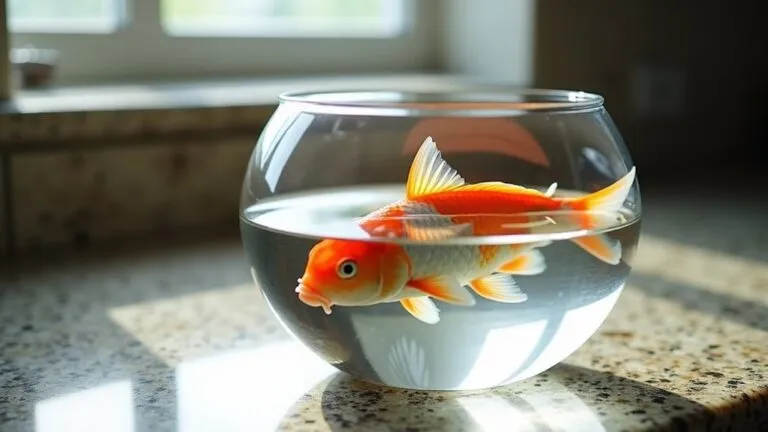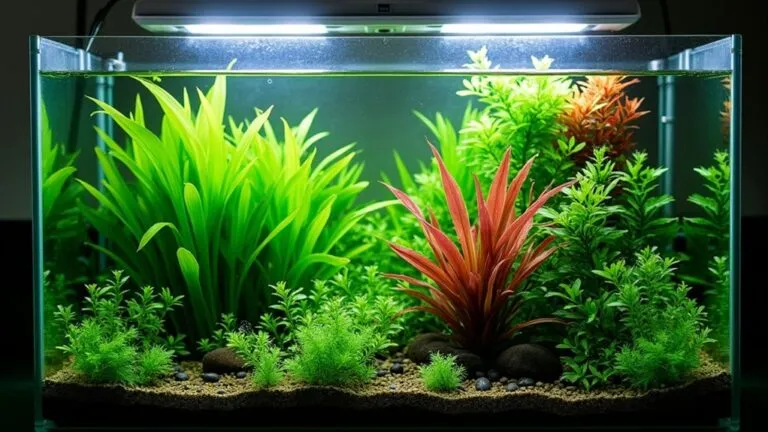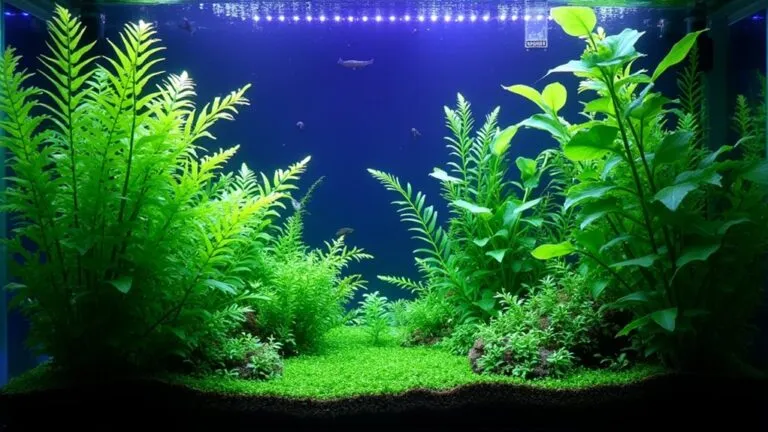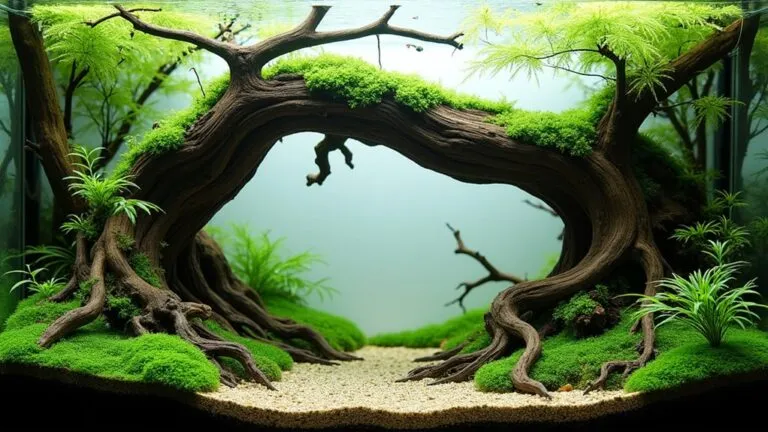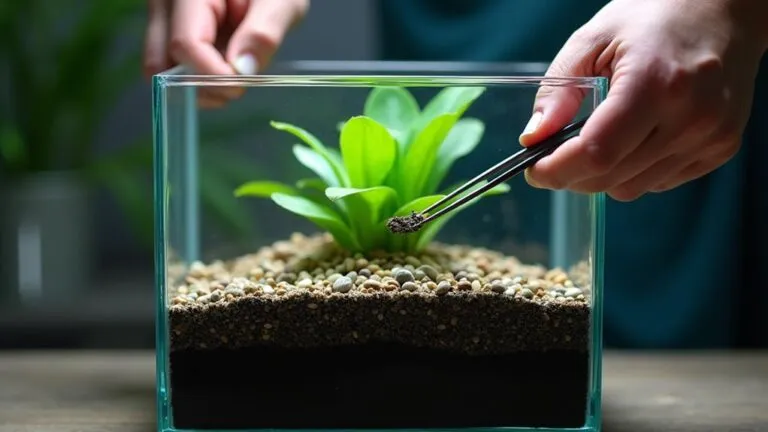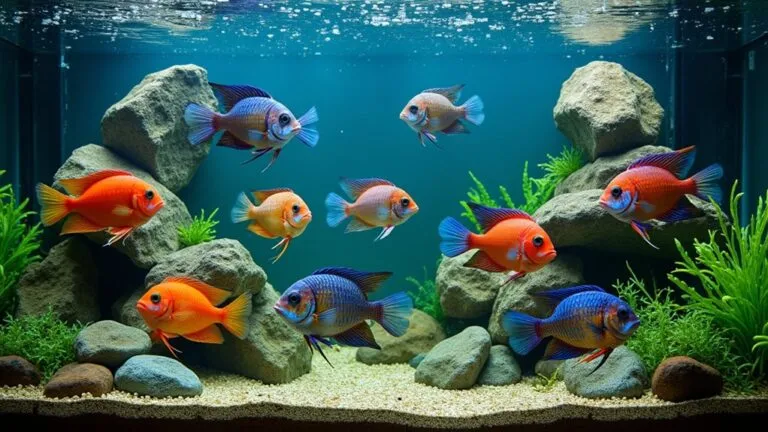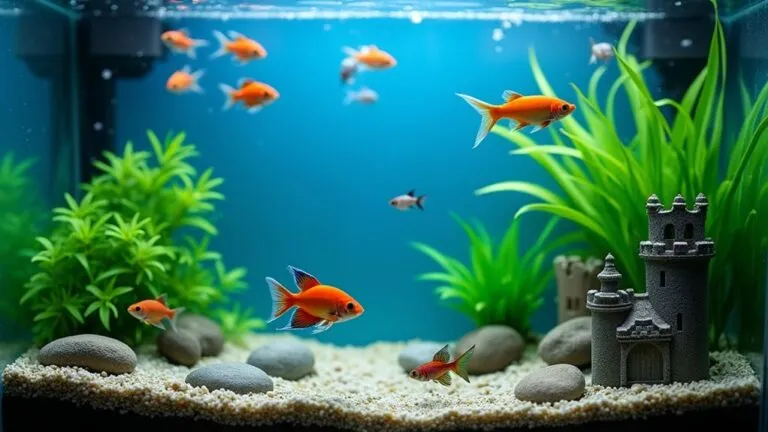When choosing your ideal fish tank, measure potential locations first, allowing extra space for maintenance access. Consider your fish species' needs—tetras work in 5-10 gallons, while community tanks need 20+ gallons. Remember that water weighs 8.3 pounds per gallon, so guarantee your floor can support the weight. Place tanks away from direct sunlight, heating vents, and high-traffic areas to maintain stable conditions. Your perfect setup balances space constraints with your fishy friends' specific requirements.
Contents
Assessing Available Space in Your Home
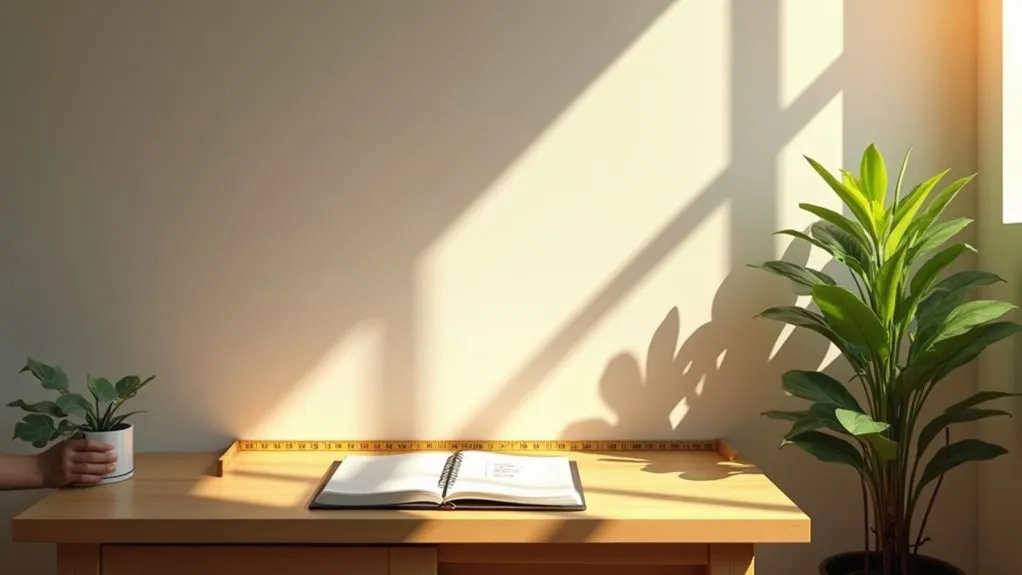
Three critical factors will determine where your fish tank belongs in your home: available space, structural support, and accessibility. Before falling in love with a massive 100-gallon aquarium, you'll need to honestly evaluate your living situation.
Grab a measuring tape and identify potential spots, keeping in mind that tanks need a few inches of clearance for equipment and maintenance.
Measure twice, place once! Allow extra space around your tank for filters, cords, and those inevitable maintenance sessions.
Consider various tank shape options to maximize your space. A tall, column-style tank might work in a corner where a traditional rectangular one wouldn't fit.
Pay attention to room lighting as well—direct sunlight can cause algae blooms and temperature fluctuations. That perfect spot by the sunny window? It's actually your tank's worst enemy! Additionally, keeping in mind proper tank size is essential to ensure the health and stability of your aquatic environment.
Tank Size Considerations for Different Fish Species
Now that you've found the perfect spot for your aquarium, let's talk about who'll be living in it. Different fish need different spaces, and there's no one-size-fits-all solution.
Small tetras and bettas can thrive in 5-10 gallon tanks, while active swimmers like danios need horizontal space to zoom around.
Tank shape considerations matter too—angelfish prefer tall, narrow tanks that mimic their natural habitat, while bottom-dwellers like corydoras appreciate longer tanks with plenty of floor space.
Don't forget about fish species compatibility when planning your tank size. Territorial cichlids require more room to establish boundaries, and schooling fish need space to form their groups.
You'll want at least 20 gallons for a community tank with multiple species, giving everyone breathing room. Maintaining water quality management is crucial to ensure a healthy environment for all the fish inhabitants.
Weight Distribution and Structural Support Requirements
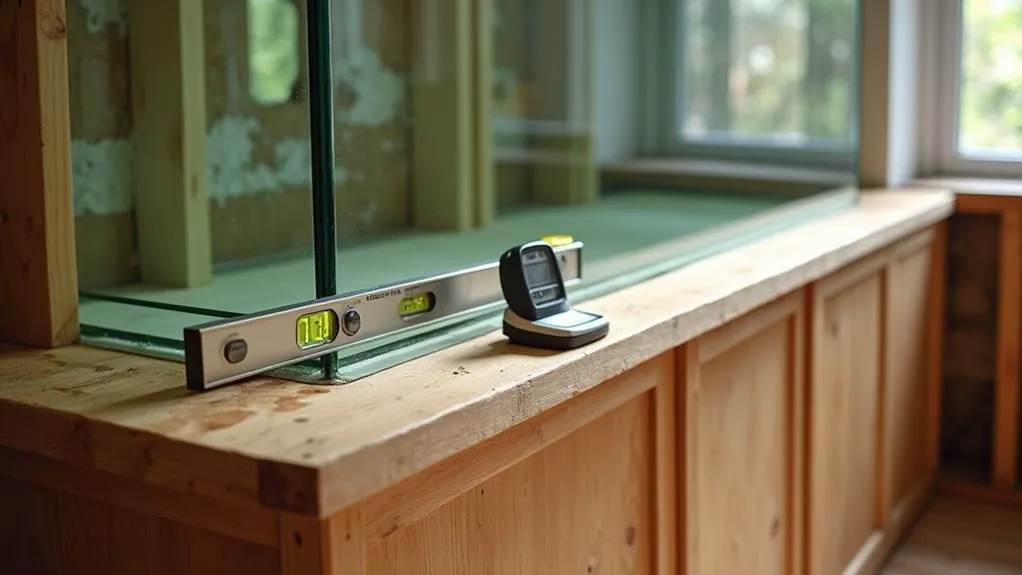
Before setting up your dream aquarium, you'll need to contemplate the surprising weight of water and glass. A gallon of water weighs about 8.3 pounds, so even a modest 40-gallon tank tips the scales at over 330 pounds when filled!
Factor in the glass, gravel, and decorations, and you're looking at serious weight. Your floor's foundation strength is vital for supporting this watery world. Don't skip those load calculations—standard residential floors can typically handle 40-50 pounds per square foot, but older homes might need reinforcement.
Place your tank perpendicular to floor joists rather than parallel to distribute weight more effectively. For larger tanks (75+ gallons), consider consulting a structural engineer. Your beautiful aquatic paradise shouldn't turn into a disaster because of overlooked support issues. Ensuring the correct tank size will help maintain fish comfort and water quality.
Trust me, your fish—and your downstairs neighbors—will thank you!
Optimal Environmental Conditions for Tank Placement
Finding the perfect spot for your aquarium involves more than just aesthetic considerations—it's about creating a stable environment where your fish can thrive.
You'll want to place your tank away from direct sunlight, which can cause algae blooms and affect water quality. Instead, opt for areas with ambient, consistent lighting that meets your specific fish's lighting requirements.
Avoid placing tanks near windows, heating vents, or air conditioners. These spots create temperature fluctuations that stress your aquatic friends—imagine if your home suddenly jumped 10 degrees every few hours!
High-traffic areas can also disturb your fish, so find a relatively quiet spot.
Your tank's location directly impacts maintenance ease too. You'll need access to outlets for equipment and proximity to water sources to make those regular water changes less of a chore. Additionally, choosing a spot that allows for easy monitoring of nitrate levels helps you maintain optimal water quality for your fish.
Accessibility for Maintenance and Daily Care

While setting up your tank in a picturesque corner might seem ideal, accessibility should be your top priority for hassle-free fish keeping.
You'll need to regularly clean the glass, vacuum substrate, and maintain filtering systems, so make certain you can easily reach all sides of your aquarium.
Consider how you'll access the top of the tank for feeding and water changes. If you're constantly stretching or using a step stool, you'll eventually skip important cleaning routines.
Remember, a well-maintained tank is a healthy one!
Leave enough space behind the aquarium to reach electrical cords, filter intakes, and heaters.
Nothing's more frustrating than discovering a problem with your equipment and not being able to fix it without moving the entire setup.
Your future self will thank you for thinking through these practical maintenance needs now. Additionally, be mindful of the ideal filter flow rate needed to keep your tank environment healthy while ensuring accessibility for maintenance tasks.
Frequently Asked Questions
How Do Aquarium Accessories Impact My Required Tank Size?
Your filter types, substrate options, lighting choices, and decor arrangements impact tank size requirements. You'll need more space for extensive equipment. Choose efficient filters and minimal decor if you're working with limited water conditions.
Can I Keep Multiple Fish Species in the Same Tank?
While many worry about aggression, you can absolutely keep multiple species together! Good fish compatibility depends on choosing peaceful tank mates with similar water requirements and providing adequate space for everyone's territories to reduce stress.
How Often Should I Upgrade Tank Size as Fish Grow?
You'll need to upgrade based on your fish's growth rate. Monitor them closely—if they appear cramped or water quality declines despite regular tank maintenance, it's time for a larger home. Plan upgrades accordingly.
Does Tank Shape Affect Fish Health as Much as Size?
Like a cramped apartment affecting your mood, tank shape impacts fish health considerably. Shallow, wide tanks promote natural fish behavior, while tall, narrow dimensions restrict swimming patterns. You'll need proper dimensions for ideal health.
What Noise Level Should I Expect From Different Tank Setups?
You'll hear different noise levels mainly from water filtration systems. Hang-on-back filters are quieter than canister types, while air pumps add bubbling sounds. Regular tank maintenance helps reduce unwanted noises from malfunctioning equipment.
Final Thoughts
You might worry that setting up a fish tank is too complicated, but don't let that stop you! With proper planning, you'll create a thriving underwater world that brings joy for years. Choose a tank size that matches your available space and the needs of your fish, guarantee proper support for the weight, place it in ideal environmental conditions, and make certain you can easily access it for care. Your perfect aquarium is within reach!

